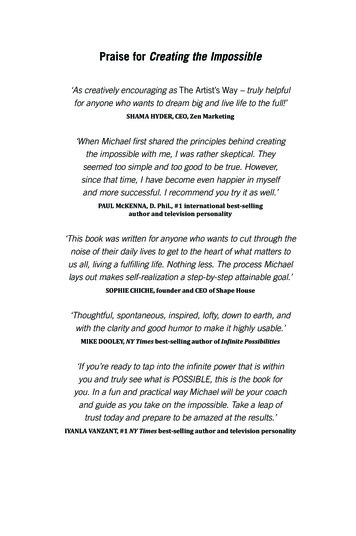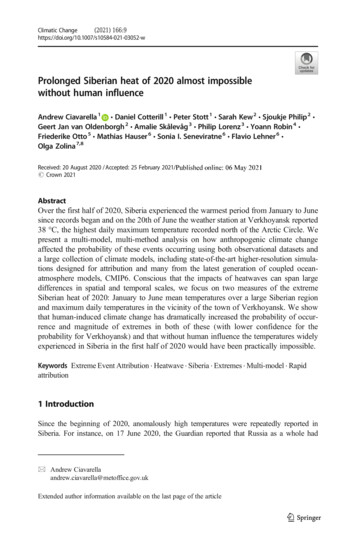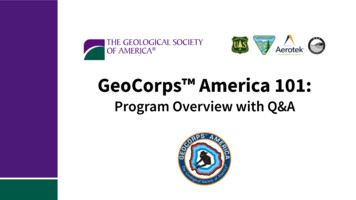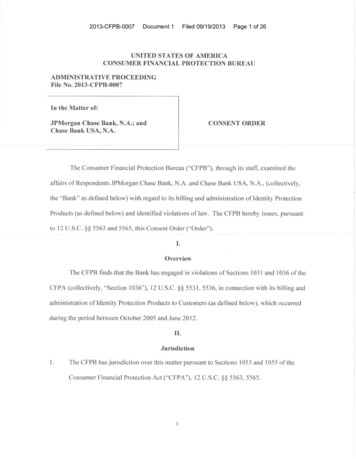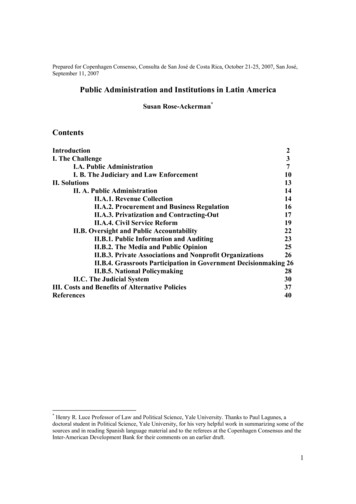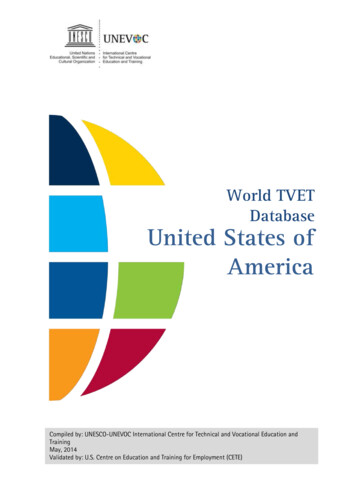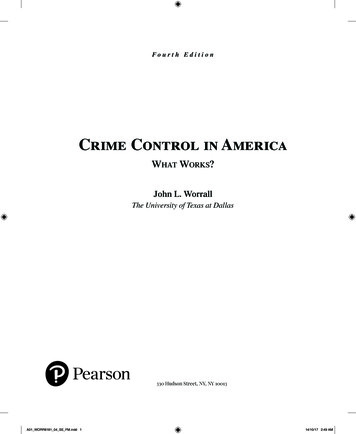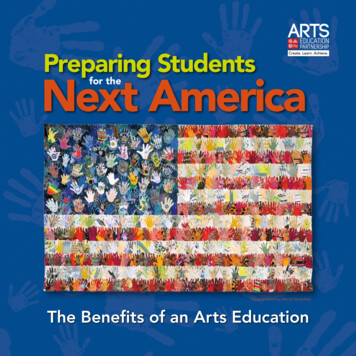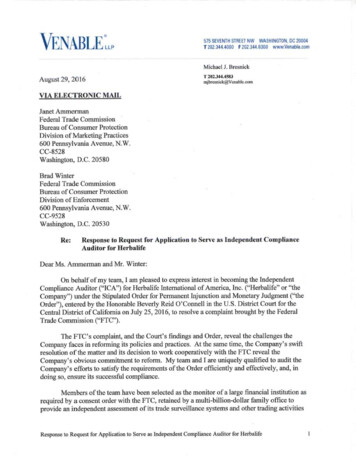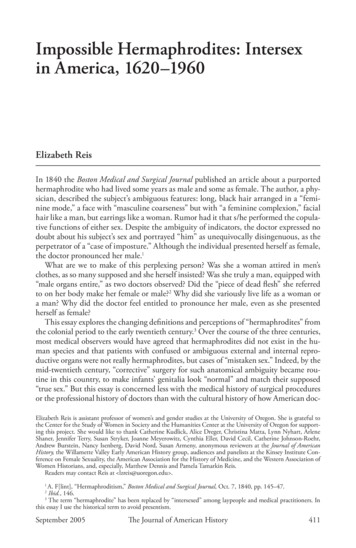
Transcription
Impossible Hermaphrodites: Intersexin America, 1620–1960Elizabeth ReisIn 1840 the Boston Medical and Surgical Journal published an article about a purportedhermaphrodite who had lived some years as male and some as female. The author, a physician, described the subject’s ambiguous features: long, black hair arranged in a “feminine mode,” a face with “masculine coarseness” but with “a feminine complexion,” facialhair like a man, but earrings like a woman. Rumor had it that s/he performed the copulative functions of either sex. Despite the ambiguity of indicators, the doctor expressed nodoubt about his subject’s sex and portrayed “him” as unequivocally disingenuous, as theperpetrator of a “case of imposture.” Although the individual presented herself as female,the doctor pronounced her male.1What are we to make of this perplexing person? Was she a woman attired in men’sclothes, as so many supposed and she herself insisted? Was she truly a man, equipped with“male organs entire,” as two doctors observed? Did the “piece of dead flesh” she referredto on her body make her female or male?2 Why did she variously live life as a woman ora man? Why did the doctor feel entitled to pronounce her male, even as she presentedherself as female?This essay explores the changing definitions and perceptions of “hermaphrodites” fromthe colonial period to the early twentieth century.3 Over the course of the three centuries,most medical observers would have agreed that hermaphrodites did not exist in the human species and that patients with confused or ambiguous external and internal reproductive organs were not really hermaphrodites, but cases of “mistaken sex.” Indeed, by themid-twentieth century, “corrective” surgery for such anatomical ambiguity became routine in this country, to make infants’ genitalia look “normal” and match their supposed“true sex.” But this essay is concerned less with the medical history of surgical proceduresor the professional history of doctors than with the cultural history of how American docElizabeth Reis is assistant professor of women’s and gender studies at the University of Oregon. She is grateful tothe Center for the Study of Women in Society and the Humanities Center at the University of Oregon for supporting this project. She would like to thank Catherine Kudlick, Alice Dreger, Christina Matta, Lynn Nyhart, ArleneShaner, Jennifer Terry, Susan Stryker, Joanne Meyerowitz, Cynthia Eller, David Cecil, Catherine Johnson-Roehr,Andrew Burstein, Nancy Isenberg, David Nord, Susan Armeny, anonymous reviewers at the Journal of AmericanHistory, the Willamette Valley Early American History group, audiences and panelists at the Kinsey Institute Conference on Female Sexuality, the American Association for the History of Medicine, and the Western Association ofWomen Historians, and, especially, Matthew Dennis and Pamela Tamarkin Reis.Readers may contact Reis at lzreis@uoregon.edu .A. F[lint], “Hermaphroditism,” Boston Medical and Surgical Journal, Oct. 7, 1840, pp. 145–47.Ibid., 146.3The term “hermaphrodite” has been replaced by “intersexed” among laypeople and medical practitioners. Inthis essay I use the historical term to avoid presentism.12September 2005The Journal of American History411
412The Journal of American HistorySeptember 2005tors and laypeople regarded bodies and identities that fell outside their conceptual boundaries of normal female and male categories. What did it mean to be male or female? Whohad authority to answer that question, and what were the criteria? The essay is organizedchronologically as well as thematically, for the classification of hermaphrodites, impossible though the status was thought to be, changed over time. Each section explores theevolving determination of the biological and social foundations of sexual identity and theanxiety, expressed differently in different eras, over those cases that did not fit the idealbipolarity.Alice Domurat Dreger, in her pathbreaking book, Hermaphrodites and the Medical Invention of Sex, has termed the years 1871–1915 the “age of gonads” in France and England. By the late nineteenth century, European doctors argued that “true hermaphrodites”were those whose bodies (examined during autopsies) contained both ovarian and testicular tissue. All others, despite unusual conformations of external genitalia, were labeled asmostly female or mostly male (male pseudohermaphrodites or female pseudohermaphrodites), and hence the two-sex system could remain largely intact. I argue that in theUnited States the impetus to maintain a two-sex system increased in the late nineteenthcentury, though it began earlier.4 Before the technology required to analyze ovarian andtesticular tissue developed, doctors focused on visual markers, particularly the penis andclitoris, though sometimes the vagina, uterus, and menstruation were offered as proof ofwomanhood. When biological cues proved inconclusive, medical men turned to socialindicators—such as a person’s mannerisms, clothing, or tastes—to make their determination of sex definitive.Physicians’ decisions involved factors, some medical, some social, that were linked tolarger cultural anxieties. American doctors discussed their European colleagues’ case histories, read European medical textbooks, and used them to formulate their own conclusions about the impossibility of hermaphrodites. In what is now the United States thetendency to proclaim hermaphrodites “impossible” began long before the age of gonads,though it became more pronounced when the observation of gonads became important,here as in Europe. Embedded in both European and American doctors’ judgments, whichlabeled ambiguous bodies male or female, were traditional notions of femininity, masculinity, and, indeed, personhood as opposed to monstrosity.Distinctive themes characterize each era’s understanding of hermaphrodites. The tropeof the monster employed in early American texts persisted in new guises in the early republic and overlapped with the developing notion of the deliberately deceptive or shadycharacter. In the nineteenth century especially, worries about gender deception and fraudmerged with apprehension over racial constancy and the stability of bodies. Whether itwas to ensure the legal status of men or women or to show that sex, like race, should besomething uncomplicated, permanent, and easy to determine, nineteenth-century doctors insisted on certainty rather than ambiguity in gender designation. Later in the century, the frightening prospect of bodily metamorphosis fused with the worrisome possibility of homosexuality. Finally, throughout we confront the issue of choice; a binarysystem of sex, the ideal established and authorized by the biblical Adam and Eve, wasrigid, and choosing an infrangible sex (despite indefinite and contradictory markers) was4Alice Domurat Dreger, Hermaphrodites and the Medical Invention of Sex (Cambridge, Mass., 1998). I am notmaking implicit claims about European history; the increase in commitment to a two-sex system may have begunearlier in Europe too, but Dreger’s work focuses on the later period.
Intersex in America, 1620–1960413mandatory. Even if according to medical authorities hermaphrodites did not exist, theidea of one body exhibiting two sexes nonetheless raised a host of anxieties about genderand sex.Technically, the doctors were right; no humans were like hermaphroditic earthworms,possessing two perfect sets of external and internal reproductive organs, capable of reproducing as either female or male. Hermaphroditus, the figure from Greek mythologywhose male body was merged by the gods with the female body of the nymph Salmacis,found no counterparts in the mortal human world. But saying that hermaphrodites didnot exist encouraged doctors and laypeople to insist on two and only two sexes, when notall bodies fit precisely into discrete male and female categories. True, most people havebodies with physical markers that are clearly male or female, but some have genitals, gonads, and genetic material sufficiently equivocal to make doctors and parents wonder towhich sex they belong. Medical experts estimate that one of every two thousand peopleis born with questionable gender status, about the same ratio as those born with cystic fibrosis. Our gendered world forces us to put all people into one of two categories when, infact, as the Harvard University biologist Anne Fausto-Sterling has suggested, we need toconsider “the less frequent middle spaces as natural, although statistically unusual.”5Sex is social and historical, in large part a construction whose contours and boundarieshave been imposed rather than simply discovered. Consider the analogy of race. Just as wethink about race in black-and-white terms in the United States, so too we think about sexin exacting binary terms. African Americans, for example, have been considered “black”on the basis of the “one-drop” rule (any known African ancestry), which sought to defineand police the boundaries between blacks and whites in the interest of white racial “purity” and supremacy.6 Although racism and discrimination persist, the one-drop rule hasdisappeared in the face of more just attitudes and practices, as Americans have redefinedthe color line in the United States in the previous half century. Today “multiracial” is anaccepted identifier employed by increasing numbers to add nuance and complexity to ourformerly rigid understanding of race.Will a more complex understanding and classification of sex find similar respectability? How distinct are the boundaries of sex? And how should those with nonconformingbodies be treated? How small must an infant’s penis be before a doctor decides the childshould be surgically remade as a girl? Does an unusually large clitoris transform a girl intoa boy? Is someone with a penis and a uterus male or female? What about a person withbreasts and testicles? Where do we place those who have both XX and XY chromosomesin this rigid taxonomy of sex? Intersex bodies have always existed, but they have beenrendered invalid and invisible historically, for the boundaries of personhood have forcedthem into a conventional bipolar male/female division.75On the incidence of intersexuality, see Dreger, Hermaphrodites and the Medical Invention of Sex, 40–43. AnneFausto-Sterling, Sexing the Body: Gender Politics and the Construction of Sexuality (New York, 2000), 76.6F. James Davis, Who Is Black? One Nation’s Definition (University Park, 1991). Sex is not like race in all respects; it has a greater claim to a basis in biology. Nonetheless, as we shall see, the rigidity of the sexual binary goesbeyond the realm of biology into the realm of culture.7On contemporary medical attitudes toward intersex births, see Suzanne J. Kessler, Lessons from the Intersexed(New Brunswick, 1998). Identifying and living as intersexed is becoming a more viable option for some adults. Fornewborns with ambiguous genitalia, intersex activists advise parents to choose a traditional sex, based on best estimates of what will help the child be most comfortable with his or her body. When the child matures physically, sheor he can choose to maintain the original assignment, live as the opposite gender, or identify as intersexed. See theIntersex Society of North America Web site for comprehensive resources: http://www.isna.org (Jan. 31, 2005).
414The Journal of American HistorySeptember 2005The insistence on a strict male/female dichotomy should not be understood as a medical conspiracy, though doctors played an enormous role in delineating the boundariesbetween the two sexes and bestowing on that division the imprimatur of science. Thoseliving with ambiguous bodies generally shared the binary ideal and sought to blend in, ifonly because survival demanded it. Forced to choose a sex, however, they did not alwaysadhere to the sex they chose. Nor did they always endorse or accept doctors’ suggestionsfor surgical correction, particularly when such surgery required an adult to change gender.The determination to make intersex bodies look like normal male or female bodies reached its apogee in the work of the psychologist John Money of Johns HopkinsUniversity in the mid-twentieth century. Money believed, erroneously, that one’s senseof gender identity was malleable until eighteen months of age. He therefore concludedthat those born with ambiguous genitalia could have their sex surgically and hormonally assigned as infants without negative consequences. Once their bodies were surgicallyshaped to approximate typical male or (usually) female figures, the children would develop personalities happily matched to their assigned sex, Money claimed, if the assignments were supported by proper rearing and a parental commitment to the chosen gender. Money was wrong. Many children thus altered never felt at home in their assignedsex. Some never knew their medical history, as doctors advised parents and relatives tokeep the matter secret. When they found out, some changed genders as adults. Othersstruggled to accommodate life with surgically altered sexual organs that had been severely compromised as well as with a deep sense of shame induced by enforced secrecy.Intersex activists are currently challenging Money’s presumptions and protocols about“normalizing” procedures. As Alice Dreger, chair of the Board of Directors of the Intersex Society of North America (ISNA), put it, “Why perform irreversible surgeries that risksensation, fertility, continence, comfort, and life without a medical reason?” ISNA’s effortsare making headway, but they are far from complete. At a recent meeting of the Sectionon Urology of the American Academy of Pediatrics, several leaders in the field cautionedagainst invasive cosmetic surgeries, while others continued to advocate early aggressiveoperations.8How nonconforming bodies are treated is a historical question. In America they havebeen marked as “other,” as monstrous, sinister, threatening, inferior, and unfortunate. Wemight imagine other possibilities, perhaps drawing on the pathbreaking work in the newhistory of disability, which invites scholars to ask how ambiguous bodies became “abnormal” bodies.9 Difference, including the sex characteristics of nonconforming bodies, neednot carry the stigma of inferiority or monstrosity. The rush to classify intersex persons asmale or female—or forcibly to make them male or female—can be seen as evidence of asocial construction that demands historical explanation. The proposition that a person’ssex might range more broadly and variably along a continuum between the two polesof conventional male and female embodiment forces us to denaturalize sex. We are thus8“Urologists: Agonize over Whether to Cut, Then Cut the Way I’m Telling You,” online posting, Oct. 14,2004, Alice Dreger’s Blog, Intersex Society of North America, http://www.isna.org (Jan. 31, 2005). See also AliceDomurat Dreger, ed., Intersex in the Age of Ethics (Hagerstown, 1999). On John Money, see John Colapinto, As Nature Made Him: The Boy Who Was Raised as a Girl (New York, 2000); and Joanne Meyerowitz, How Sex Changed:A History of Transsexuality in the United States (Cambridge, Mass., 2002), 112–19.9Catherine Kudlick, “Disability History: Why We Need Another ‘Other,’” American Historical Review, 108(June 2003), 763–93.
Intersex in America, 1620–1960415challenged as historians to analyze how and why a rigid male/female dichotomy was enforced, how it assumed unquestioned status as biologically natural, and how it affectedthose whose anatomy did not conform as well as those whose bodies were considerednormal. This essay therefore considers how the criteria and the authority for judging ambiguous bodies changed over time, even as the anxiety over ambiguity persisted and thebinary sexual ideal endured. How Americans have understood and handled nonconforming bodies reveals not merely the hidden history of intersex, but the process by whichAmericans defined and naturalized the norms of sex and gender.Early Americans placed hermaphrodites in the broader category of monstrous births, acatchall that included all kinds of birth anomalies. Monsters, few doubted, were sent byGod as signals and warnings. Puritan theologians agreed on the doctrine of providence;if God ordered the universe, every unusual event had divine significance. Sometimes Godsent subtle signs; at other times, presumably depending on the importance of the occasion, his messages were more obvious. Mary Dyer’s unfortunate malformed baby was onesuch blatant expression, understood to be a dramatic expression of God’s censure. Dyerhad been a follower of Anne Hutchinson (a woman expelled from the Massachusetts BayColony for criticizing established clergy, expounding the doctrine of “grace in the heart,”and testing the limits of female autonomy in matters of faith), and she later became aQuaker. In 1637 Dyer gave birth to a terribly misshapen baby that John Winthrop, thecolony’s governor, described:it was a woman child, stillborn, about two months before the just time, having life afew hours before; it came hiplings till she turned it; it was of ordinary bigness; it hada face, but no head, and the ears stood upon the shoulders and were like an ape’s;it had no forehead, but over the eyes four horns, hard and sharp; two of them wereabove one inch long, the other two shorter; the eyes standing out, and the mouthalso; the nose hooked upward; all over the breast and back full of sharp pricks andscales, like a thornback; the navel and all the belly, with the distinction of sex, werewhere the back should be, and the back and hips before, where the belly shouldhave been; behind, between the shoulders, it had two mouths, and in each of thema piece of red flesh sticking out; it had arms and legs as other children; but, insteadof toes, It had on each foot three claws, like a young fowl, with sharp talons.10The Reverend John Cotton suggested that Dyer conceal the birth. He saw “a providence of God in it . . . and had known other monstrous births, which had been concealed,and that he thought God might intend only the instruction of the parents, and such otherto whom it was known, etc.” But God apparently wanted all to know, for even duringlabor, about two hours prior to the birth, Winthrop ascertained, the bed shook violently,and Dyer’s body emitted a “noisome savor.” Such shaking and the foul smell indicatedthat Satan lurked nearby. Most of the women attending Dyer “were taken with extremevomiting and purging” and were forced to leave.1110Richard S. Dunn, James Savage, and Laetitia Yeandle, eds., The Journal of John Winthrop, 1630–1649 (Cambridge, Mass., 1996), 253–54. On monstrosity in the early modern world, see Katherine Park and Lorraine Daston,Wonders and the Order of Nature, 1150–1750 (New York, 1998); and Marie-Hélène Huet, Monstrous Imagination(Cambridge, Mass., 1993). On Puritan interpretation of signs, see David D. Hall, Worlds of Wonder, Days of Judgment: Popular Religious Belief in Early New England (New York, 1989).11Dunn, Savage, and Yeandle, eds., Journal of John Winthrop, 254–55.
416The Journal of American HistorySeptember 2005Though Winthrop assigned blame to Dyer only tentatively (he never explicitly tiedher unsuitable religious leanings to the stillborn baby), other Puritans and their contemporaries saw a direct correlation between monstrous births and dangerous opinions. In asixteenth-century English text dealing with such deliveries, the conclusion was unequivocal. These births, it explained,signifie the monstrous and deformed myndes of the people mysshapened withphantastical opinions, dissolute lyvynge, licentious talke, and such other viciousbehavoures which mounstrously deformed the myndes of men in the syght of godwho by suche signes dooth certifie us in what similitude we appere before hym,and thereby gyveth us admonition to amende before the day of his wrath and vengeance.Dyer no doubt indulged in all four sins specified: fantastic opinions, dissolute living,licentious talk, and vicious behaviors such as her claim of revelations, or supernaturalcommunication. As a result, she received God’s explicit physical condemnation in thefigure of the malformed child. The account of Dyer’s daughter’s birth by the Puritanminister Thomas Weld concurred: “Then God himselfe was pleased to step in with hiscasting voice . . . by testifying his displeasure against their [Dyer’s and Hutchinson’s]opinions and practices, as clearly as if he had pointed with his finger.”12Winthrop’s horrific description of Mary Dyer’s baby conformed to other colonial portrayals of birth anomalies. Aristotle’s Master-Piece, the most popular and often-reprintedmedical manual in the colonies and the definitive word on matters of reproduction andgenital anatomy, included accounts of creatures born with composite animal, human, andmythic features. The book detailed a case in 1393, for example, when a woman copulatedwith a dog, producing a beast that resembled the mother from the waist upward and thedog, with paws and a tail, from the waist down. (See figure 1.) The Master-Piece includeda similarly composite hermaphroditic creature, thus explicitly linking inhuman monstersand hermaphrodites. The “monster,” as the Master-Piece termed it, was born in 1512 inRavenna, with a horn on the top of its head and two wings; it stood on only one foot,which had talons like those of a large bird. It had “the Privities of Male and Female, therest of the Body like a Man, as you may see by this Figure.” The creature is not specificallylabeled a hermaphrodite, but the description of its “privities” conforms to the colonialunderstanding that a hermaphrodite had both male and female genitals.13Monstrous births of all sorts had gendered explanations; for example, their irregularities were often attributed to maternal imagination. According to another edition of the12The Decades of the Newe Worlde of West India, trans. Richard Eden, 1555, in The First Three English Books onAmerica, 1511–1555 A.D., ed. Edward Arber (1885; New York, 1971), 53. On John Winthrop’s interpretation ofmonstrous births as heavenly portents, see Robert Blair St. George, Conversing by Signs: Poetics of Implication inColonial New England Culture (Chapel Hill, 1998), 169–73. See also Katherine Park and Lorraine J. Daston, “Unnatural Conceptions: The Study of Monsters in Sixteenth- and Seventeenth-Century France and England,” Past andPresent, no. 92 (Aug. 1981), 20–54; and Johan Winsser, “Mary Dyer and the ‘Monster’ Story,” Quaker History, 79(Spring 1990), 20–34. For Thomas Weld’s statement, see David D. Hall, ed., The Antinomian Controversy, 1636–1638: A Documentary History (Durham, 1990), 214.13Aristotle [pseud.], Aristotle’s Master-Piece; or, The Secrets of generation Displayed in all the Parts Thereof . . .very necessary for all Midwives, Nurses, and Young-Married Women (London, 1694), 180–81. See Mary E. Fissell,“Hairy Women and Naked Truths: Gender and the Politics of Knowledge in Aristotle’s Masterpiece,” William andMary Quarterly, 60 (Jan. 2003), 1. Fissell notes that the Master-Piece went into more editions than all other bookson the subject combined. On the differences between editions and the book’s popularity, see Vern L. Bullough, “AnEarly American Sex Manual; or, Aristotle Who?,” Early American Literature, 7 (Winter 1973), 236–46; and HelenLefkowitz Horowitz, Rereading Sex: Battles over Sexual Knowledge and Suppression in Nineteenth-Century America(New York, 2002).
Intersex in America, 1620–1960417Figure 1. Many editions of Aristole’s Master-Piece, a famous colonial medical manual,included pictures of monstrous creatures reportedly born to women. Though notspecifically called a hermaphrodite, the “Winged Monster” on the right had “thePrivities of Male and Female.” Image from Aristotle’s Master-Piece, 1697, in possessionof the British Library. Courtesy ProQuest Information and Learning Company. Furtherreproduction is prohibited without permission.Master Piece, a pregnant woman’s thoughts or impressions could cause a birth anomaly. Ifa pregnant woman saw a rabbit, for instance, her child might be born with a harelip, themanual cautioned. “Some Children are born with flat Noses, wry Mouthes, great blubberLips, and ill-shap’d Bodies; and most ascribe the reason to the Imagination of the Mother,who hath cast her Eyes and Mind upon some ill-shap’d Creature.”14 Pregnant women werecautioned to steer clear of such sights or at least to avoid staring at them.For similar reasons, the Master Piece advised women to abstain from sex during themenstrual period. “Undue copulation,” the book explained, was “unclean and unnatural.”The “issue of such Copulation does oftentimes prove Monstrous, as a just Punishment fortheir Lying together, when Nature bids they should forbear.” Women and men were bothto blame for bad coital timing, though most of the onus was put on women to preventsuch activities; a woman should know her body’s condition and, if necessary, refuse herpartner. Whoever was to blame, the Master Piece made clear that one cause for monstrousbirths was divine: “Because the outward Deformity of the body, is often a Sign of the Pollution of the Heart, as a Curse laid upon the Child for the Parents Incontinency.”15In early American medical texts, authors usually discussed hermaphrodites in relationto monstrous births. The discussion of monstrosity typically included three questions:14Aristotle’s Master Piece, Completed in Two Parts: The First Containing the Secrets of Generation in all the PartsThereof (London, 1700), 17. By the early nineteenth century, doubt about maternal imagination as an explanationfor unusual births began to creep into doctors’ accounts, though the tone of many articles suggests that the ideahad not been completely dispelled. See, for example, Thomas Close, “Singular Monstrosity,” Boston Medical Intelligencer, Sept. 13, 1825, p. 71. The idea flourished again in the late nineteenth century, in the context of attackson it. See Michel Middleton, “Cases of Malformation: with Reflections on Congenital Abnormalities,” AmericanJournal of the Medical Sciences, 55 (Jan. 1868), 69–76.15Aristotle’s Master Piece (1700), 40, 35.
418The Journal of American HistorySeptember 2005“What is the cause of monsters? Whether they are possessed of life? Whether a perfectmonster can be considered a human being?” Aristotle’s Master Piece maintained that thoseconceived by “natural means,” as opposed to an “unnatural” union between a woman anda beast, “tho their outward Shape may be deformed and monstrous; have notwithstanding a reasonable Soul, and consequently their Bodies are capable of a Resurrection.” Thesame theological and medical questions were asked about hermaphrodites. Most writersacknowledged the humanity of those born “imperfect monsters,” in which only part ofthe body, such as the genitals, was affected, and lamented the sorry fate that befell “perfect monsters,” which resembled “brute animals” and were deemed more monstrous thanhuman.16The first case of ambiguous sex that has been found in early American sources did notengage any concerns about monstrosity, maternal imagination, or the ensoulment of hermaphrodites, for in 1629 an adult, Thomas/Thomasine Hall, came to the attention of theVirginia General Court for dressing “in weomans apparel.” During the investigation intothis matter, other issues came to light. Rumor had it that Hall had had sex with a maid,“greate Besse.” According to the historian Mary Beth Norton, a clear determination ofanomalous sex would have been required to assess that act: For Thomas, it would havebeen considered fornication, a not uncommon offense in seventeenth-century Virginia,but for Thomasine, it might have meant very little (for same-sex liaisons were condemnedprimarily when they involved men), or it might have been construed as an “unnaturalact.” The court was determined to ascertain Hall’s true identity: Was he a man or a woman? The case demonstrates the potential fluidity of gender in the early modern period.We see both Hall’s flexible, laissez-faire perspective and the authorities’ attempt to imposeprecise gender rules that would reflect and announce Hall’s equivocal condition.17Hall explained his history to the court. Having been baptized a girl, Thomasine, shelived as a girl at home near Newcastle upon Tyne until she was twelve years old. She wasthen sent to her aunt’s residence in London, where she spent another ten years. When herbrother was pressed into military service, Hall decided to cut her hair, don men’s clothes,and become a soldier. Upon returning to Plymouth from military service, according tothe court’s deposition, “hee changed himselfe into woemans apparel and made bone laceand did other worke with his needle.” After a while she decided once again to put onmen’s clothes and came to Virginia as an indentured servant. Here, despite Hall’s status asa bound laborer, s/he continued to cross back and forth between the genders.1816Samuel Farr, Elements of Medical Jurisprudence, in Tracts on Medical Jurisprudence, by Thomas Cooper (Philadelphia, 1819), 1–80, esp. 11. Farr’s book, first published in 1787, was published in America in the nineteenthcentury. Aristotle’s Master Piece (1700), 41.17H. R. McIlwaine, ed., Minutes of the Council and General Court of Colonial Virginia, 1622–1632, 1670–1676(Richmond, 1924), 194–95, esp. 195. For interpretations of Thomas/Thomasine Hall’s life, see Mary Beth Norton, Founding Mothers and Fathers: Gendered Power and the Forming of American Society (New York, 1996), 183–97;and Kathleen Brown, “‘Changed . . . into the Fashion of Man’: The Politics of Sexual Difference in a SeventeenthCentury Anglo-American Settlement,” Journal of the History of Sexuality, 6 (Oct. 1995), 171–93. See also Alden T.Vaughan, “The Sad Case of Thomas(ine) Hall,” Virginia Magazine of History and Biography, 86 (April 1978), 146–48; and Jonathan
September 2005 The Journal of American History 411 In 1840 the Boston Medical and Surgical Journal published an article about a purported hermaphrodite who had lived some years as male and some as female. The author, a phy-sician, described the subject’s

